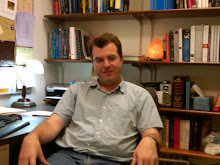The Sidereal Messenger is an essay describing Galileo's first telescope observations. Galileo is sometimes lionized as a hero of unconventional thought. While his thoughts may have rubbed some people the wrong way on religious or political grounds, his writings would fit right into the mainstream of todady's scientific community, and not just because his theories happen to be right. Galileo opens his essay with profuse gratitude to the Duke of Tuscany; the modern equivalent would be a Powerpoint slide thanking the funding agency. He then describes his method of calibration for determining his telescope's magnification. Were I reviewing his paper for a journal I would probably ask for more details of his equipment, seeing as how he was using the world's second telescope and hence the methodological details were not yet widely known in the scientific community. However, we'll cut him some slack, given that these professional conventions were still being worked out by scientists.
His next set of observations concerns mountains on the moon. Some popular accounts make it sound as though he simply looked up and saw things that look like Aspen, CO. In fact, his telescope was far too crude for that. Mostly he was looking at things sticking out on the edge of the moon, and seeing that the crescent moon is not a perfectly smooth crescent. There are peaks that stick out and catch light that would not have been caught at ground level. He deduced the presence of mountains from subtle inhomogeneities. This is very much of a piece with a great deal of experimental and observational science today. People rarely get to do a clean experiment where something stands out as clear as the "artist's depiction" in a newspaper article, or even the simple models in textbooks. The real signal is almost always too noise and complicated for that, and is influenced by many different factors. Instead, a great deal of indirect inference is used to go from a raw signal to something meaningful.
His lunar observations are followed by a short section describing how he was able to see stars in the constellations that were too faint to be seen by the naked eye. However, his longest section described two months of painstaking observations of Jupiter's four largest moons. He didn't simply look up and say "Hey, there are things going around Jupiter! It has moons just like earth! Clearly, the heavens and the earth are exactly the same!" Instead, he spent months observing again and again, seeing a pattern of objects in the sky that were always in the vicinity of Jupiter but changed their position relative to Jupiter. It was only from a couple months of observations that he had the data necessary to argue that Jupiter has satellites.
Interestingly, near the end, Galileo plays both sides on the heliocentric model. On the one hand, he describes the satellites of Jupiter as orbiting Jupiter every few days while simultaneously orbiting earth every 12 years. On the other hand, he also says that this observation helps to support the heliocentric model, by arguing that these observations make Jupiter more earth-like (in that it has satellites) and hence undermine the unique status of earth.
All in all, I recommend publication of this paper.
Subscribe to:
Post Comments (Atom)



No comments:
Post a Comment